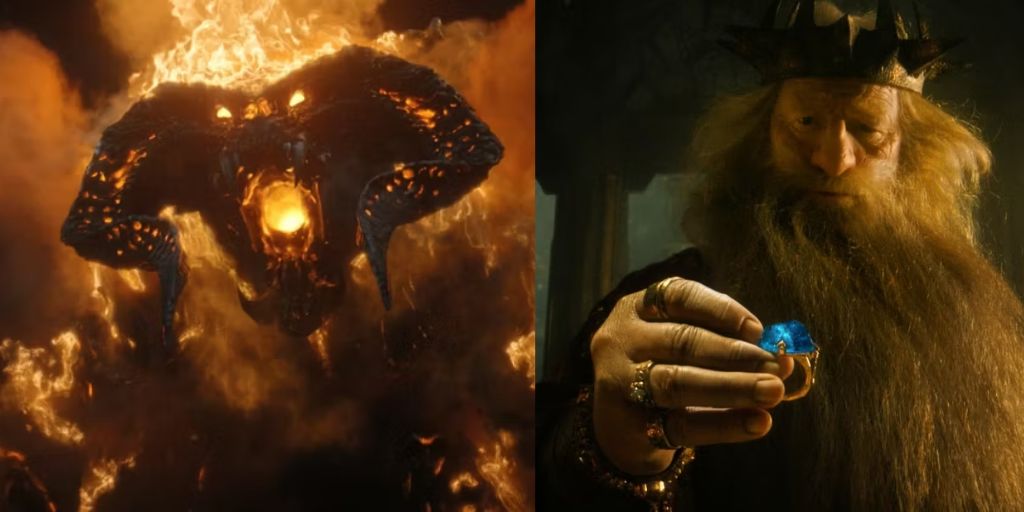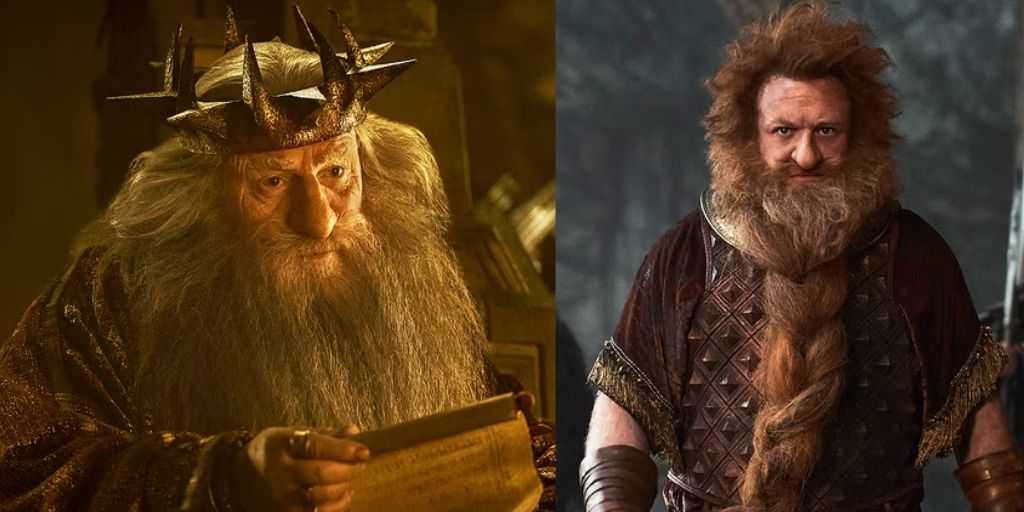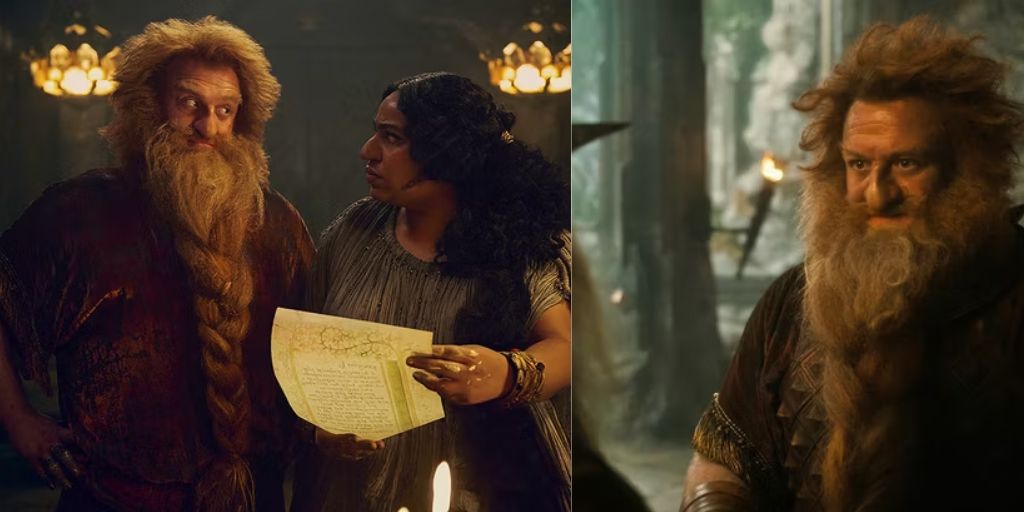A new set of Rings of Power arrives in the latest episode, “Halls of Stone,” from The Lord of the Rings: The Rings of Power Season 2. The episode begins with King Durin III (played by Peter Mullan) receiving his own ring while six other rings remain for their future owners.
As soon as King Durin puts on his ring, everything in Khazad-dûm starts to shift, and he immediately works on solving the issue of sunlight beneath the mountain. The ring’s power seems to bring immediate positive changes, but the question remains: will these changes last in the long run? Also, which Dwarves will receive the other six rings?
What Are the Powers of the Dwarven Rings?
In The Rings of Power, Celebrimbor (Charles Edwards) and Annatar (Charlie Vickers) first offer the idea of the Dwarven Rings to Prince Durin IV (Owain Arthur) and his wife, Disa (Sophia Nomvete), in Episode 3 of Season 2, titled “The Eagle and the Scepter.”
These rings are the second set of Rings of Power, created after the three Elven Rings in Season 1. However, in the books, they are forged first along with the Nine Rings for Men by Celebrimbor and Annatar, who is actually Sauron in disguise. The Elven Rings are crafted later by Celebrimbor alone.
The Dwarven Rings are created to continue the work of the Elven Rings by stopping the spread of darkness in Middle-earth. In the books, these rings are meant to preserve light, strengthen the bonds between Elves and Dwarves, and bring prosperity.
However, Sauron, who helped create these rings, had a hidden motive. He wanted to use the rings to control the Dwarf-lords. Because of Sauron’s involvement in their creation, the Dwarven Rings are filled with his malice and become dangerous, even more so than the Elven Rings.
The Dwarven Rings grant their bearers a long life, preventing them from aging as quickly. However, due to Sauron’s influence, the rings do not work exactly as they were meant to. Instead of bringing prosperity, the rings bring greed.
This is clearly seen in King Durin III throughout the episode. He says that the ring allows him to “see the mountain” and discover its hidden treasures, but this turns him into a greedy treasure hoarder. He even uses the other rings to impose heavy taxes on the other Dwarf-lords.

The Dwarven Rings also do not fully bend to Sauron’s will. His plan was to make the rings work like the Nine Rings for Men, binding their bearers to him.
However, the Dwarves show surprising resistance. The two main effects of the rings are greed and longevity, and they do not grant any special powers like the ability to see through rocks. Eventually, greed proves to be the most harmful effect of the rings.
Who Are the Dwarves That Receive the Rings of Power?
When thinking about the Rings of Power, many people recall the famous verses from J.R.R. Tolkien’s poem that describe how many rings were given to each race in Middle-earth. So far, The Rings of Power has shown the first verse come to life: “Three rings for Elven-kings under the sky.”
Now, it’s time for the second verse: “Seven for the Dwarf-lords in their halls of stone.” In this week’s episode, we see the seven rings being presented to the Dwarves, who will soon carry them across Middle-earth.
When King Durin III reveals the remaining six rings, he makes it clear they are not yet for their bearers. He even tells one Dwarf that the rings are for his “master.” This scene involves emissaries from other Dwarf-lords, suggesting that the series will eventually reveal who will receive the Rings of Power.
Even in Tolkien’s books, there is no detailed list of the Dwarves who receive these rings, only that they are members of the most powerful Dwarven clans: Durin’s Folk (or Longbeards), Broadbeams, Firebeards, Ironfists, Stiffbeards, Blacklocks, and Stonefoots. Over time, these rings are likely passed down through these families.
King Durin III’s ring is the only Dwarven Ring with a well-known history. It is passed down from Durin III to Durin VI, the ruler during the time when the Dwarves dig too deeply and awaken the Balrog of Moria.
Both Durin VI and his heir, Náin, are killed within a year of each other, and the ring is eventually passed down to Thráin II, the father of Thorin Oakenshield (played by Richard Armitage in The Hobbit). Thráin is a troubled king, heartbroken over the loss of Erebor to the dragon Smaug.
He later leaves his people and tries to reach the abandoned Khazad-dûm during the Third Age. Unfortunately, Sauron, who is disguised as the Necromancer in the fortress of Dol Guldur, captures and kills Thráin, taking his ring in the process.
What Happens to the Dwarven Rings of Power?
By the end of the Third Age, none of the seven Dwarven Rings remain with the Dwarves. After Sauron’s defeat in the War of the Last Alliance, it takes time for him to rebuild his strength in the Third Age.
When he does, one of his goals is to reclaim the Rings of Power. While the Nine Rings for Men are still in his control through the Nazgûl, the seven Dwarven Rings prove harder to recover.

Sauron is able to reclaim three of the Dwarven Rings, including Thráin’s ring. The other four are destroyed by dragons. The Dwarves who wear these rings amass great wealth, which attracts the attention of dragons.
This is similar to what happens with Smaug in The Hobbit, who is drawn to Erebor. Over time, these dragons either kill the Dwarves or destroy their strongholds, consuming the rings in the process.
New episodes of The Rings of Power Season 2 are available on Prime Video, with fresh episodes airing every Thursday in the U.S.





